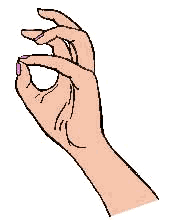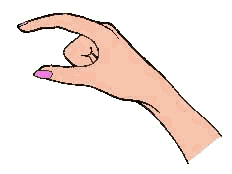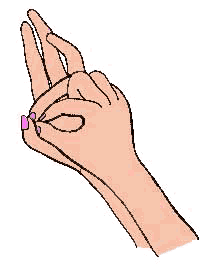Kinesiology: The Tool for Testing
Kinesiology is another word for muscle testing. Kinesiology is simple. Anybody can do it because it uses your electrical system and your muscles. If you are alive, you have these two things. I know that sounds smart-mouthed of me, but Iíve learned that sometimes people refuse to believe that anything can be so simple. So they create a mental block—only "sensitive types" can do this, or only women can do it. Itís just not true. Kinesiology happens to be one of those simple things in life just waiting around to be learned and used by everyone.
Even small children can learn to do kinesiology in about five minutes. It is mainly because it never occurred to them that they couldnít do it. If I tell them they have an electrical system, they donít argue with me about it; they just get on with the business of learning how to do simple testing. Actually, I do mean to intimidate you. Your first big hurdle will be whether or not you believe you have a viable electrical system that is capable of being tested. Hereís a good test. Place a hand mirror under your nose. If you see breath marks, you have a strong electrical system. (If you donít see breath marks, call your local emergency rescue squad—youíre in trouble.) Now you can get on with learning how to use kinesiology!
If youíve ever been to a chiropractor or holistic physician experienced in muscle testing, youíve experienced kinesiology. The doctor tells you to stick out your arm and resist his pressure. It feels like he is trying to push your arm down after he has told you not to let him do it. Everything is going fine, and then all of a sudden he presses and your arm falls down like a floppy fish no matter how hard you try to keep it up. That is using kinesiology.
Simply stated, the body has within it and surrounding it an electrical network or grid. If anything impacts your electrical system that does not maintain or enhance your health and your bodyís balance, your muscles, when having physical pressure applied, are unable to hold their strength. (Muscle power is directly linked to the balance of the electrical system.) In other words, if pressure is applied to an individualís extended arm while his bodyís electrical system is being adversely affected, the muscles will weaken and the arm will not be able to resist the pressure. The circuits of the electri-cal system are overloaded or have short-circuited, causing a weakening of that system. However, if pressure is applied while his electrical system is being positively affected, the circuits remain strong, balanced and capable of fully functioning throughout the body. The muscles will remain strong, the person will easily resist and the arm will hold its position.
This electrical/muscular relationship is a natural part of the human system. It is not mystical or magical. Kinesiology is the established method for reading the bodyís balance through the balance of the electrical system at any given moment.
When working in a co-creative partnership, nature answers your yes/no questions by projecting a positive energy or a negative energy—whichever is appropriate—into the electrical circuit that you have created by your fingers especially for the kinesiology testing. The "yes" or "no" that nature projects registers in this one electrical connection and not throughout your entire electrical system. The special connection created by your fingers allows you to use the kinesiology technique without adversely impacting your electrical system or your bodyís balance. Only one circuit is being used, and this circuit is artificially created by you for the testing and is not a part of the normal function of the electrical system throughout your body. The answer you are able to discern through the testing is from nature. It is not an answer that has been concocted by you.
If you have ever experienced muscle testing, you probably participated in the above-described, two-person operation. You provided the extended arm, and the other person provided the pressure. Although efficient, this can sometimes be cumbersome when you want to test something on your own. Arm pumpers have the nasty habit of disappearing right when you need them most.
Kinesiology Self-Testing Steps
1. THE CIRCUIT FINGERS. If you are right-handed: Place your left hand palm up. Connect the tip of your left thumb with the tip of the left little finger (not your index finger). If you are  left-handed: Place your right hand palm up. Connect the tip of your right thumb with the tip of your right little finger. By connecting your thumb and little finger, you have closed an electrical circuit in your hand, and it is this circuit you will use for testing.
left-handed: Place your right hand palm up. Connect the tip of your right thumb with the tip of your right little finger. By connecting your thumb and little finger, you have closed an electrical circuit in your hand, and it is this circuit you will use for testing.
Before going on, look at the position you have just formed with your hand. If your thumb is touching the tip of your index or first finger, laugh at yourself for not being able to follow directions, and change the position to touch the tip of the thumb with the tip of the little or fourth finger. Most likely this will not feel at all comfortable to you. If you are feeling a weird sense of awkwardness, youíve got the first step of the test position! In time, the hand and fingers will adjust to being put in this position and it will feel fine.
Circuit fingers can touch tip to tip, finger pad to finger pad, or thumb resting on top of the little fingerís nail. Women with long nails need not impale themselves.
2. THE TEST FINGERS. To test the circuit (the means by which you will apply pressure to  yourself), place the thumb and index finger of your other hand inside the circle you have created by connecting your thumb and little finger. The thumb and index finger should be right under your thumb and your little finger, touching them. Donít try to make a circle with your test fingers. They are just placed inside the circuit fingers that do form a circle. It will look as if the circuit fingers are resting on the test fingers.
yourself), place the thumb and index finger of your other hand inside the circle you have created by connecting your thumb and little finger. The thumb and index finger should be right under your thumb and your little finger, touching them. Donít try to make a circle with your test fingers. They are just placed inside the circuit fingers that do form a circle. It will look as if the circuit fingers are resting on the test fingers.
3. POSITIVE RESPONSE. Keeping this position, ask yourself a yes/no question in which you already know the answer to be yes. ("Is my name _____?") Once youíve asked the  question, press your circuit fingers together, keeping the tip-to-tip position. Using the same amount of pressure, try to pull apart the circuit fingers with your test fingers. Press the lower thumb against the upper thumb, and the lower index finger against the upper little finger.
question, press your circuit fingers together, keeping the tip-to-tip position. Using the same amount of pressure, try to pull apart the circuit fingers with your test fingers. Press the lower thumb against the upper thumb, and the lower index finger against the upper little finger.
The action of your test fingers will look like scissors separating as you apply pressure to your circuit fingers. The motion of the test fingers is horizontal. Donít try to pull your test fingers vertically up through your circuit fingers. This action sometimes works but it is not as reliable as the horizontal scissors action.
The circuit position described in step 1 corresponds to the position you take when you stick your arm out for the physician. The testing position in step 2 is in place of the physician or other convenient arm pumper. After you ask the yes/no question and you press your circuit fingers tip-to-tip, that is equal to the doctor saying, "Resist my pressure." Your circuit fingers now correspond to your outstretched, stiffened arm. Trying to pull apart those fingers with your testing fingers is equal to the doctor pressing down on your arm.
If the answer to the question is positive (if your name is what you think it is!), you will not be able to easily push apart the circuit fingers. The electrical circuit will hold, your muscles will maintain their strength, and your circuit fingers will not separate. You will feel the strength in that circuit.
IMPORTANT: Be sure the amount of pressure holding the circuit fingers together is equal to the amount of your testing fingers pressing against them. Also, donít use a pumping action in your test fingers when applying pressure to your circuit fingers. Use an equal, steady and continuous pressure.
Play with this a bit. Ask a few more yes/no questions that have positive answers. Now, I know it is going to seem that if you already know the answer to be "yes," you are probably "throwing" the test. Thatís reasonable, but for the time being, until you get a feeling for what the positive response feels like, youíre going to need to deliberately ask yourself questions with positive answers.
While asking questions, if you are having trouble sensing the strength of the circuit, apply a little more pressure. Or consider that you may be applying too much pressure and pull back some. You donít have to break or strain your fingers for this; just use enough pressure to make them feel alive, connected and alert.
4. NEGATIVE RESPONSE. Once you have a clear sense of the positive response, ask yourself a question that has a negative answer. Again press your circuit fingers together and, using  equal pressure, press against the circuit fingers with the test fingers. This time the electrical circuit will break and the circuit fingers will weaken and separate. Because the electrical circuit is broken, the muscles in the circuit fingers do not have the power to easily hold the fingers together. In a positive state the electrical circuit holds, and the muscles have the power to keep the two fingers together.
equal pressure, press against the circuit fingers with the test fingers. This time the electrical circuit will break and the circuit fingers will weaken and separate. Because the electrical circuit is broken, the muscles in the circuit fingers do not have the power to easily hold the fingers together. In a positive state the electrical circuit holds, and the muscles have the power to keep the two fingers together.
How much your circuit fingers separate depends on your personal style. Some peopleís fingers separate a lot. Otherís barely separate at all. Mine separate about a quarter of an inch. Some peopleís fingers wonít separate at all, but theyíll definitely feel the fingers weaken when pressure is applied during a "no" answer. Give yourself time and let your personal style develop naturally.
Also, if you are having a little trouble feeling anything, do your testing with your forearms resting in your lap. This way you wonít be using your muscles to hold up your arms while trying to test.
Play with negative questions a bit, and then return to positive questions. Get a good feeling for the strength between your circuit fingers when your electrical system is balanced and the weakness when it is short-circuited or imbalanced. You can even ask yourself (your own system) for a positive response and then, after testing, ask for a negative response. ("Give me a positive response." Test. "Give me a negative response." Test.) You will feel the positive strength and the negative weakness. In the beginning, you may feel only a slight difference between the two. With practice, that difference will become more pronounced. For now, it is just a matter of trusting what you have learned; and practicing.
Donít forget the overall concept behind kinesiology. What enhances our body, mind and soul makes us strong. Together, our body, mind and soul create an environment that, when balanced, is strong and solid. If something enters that environment and challenges the balance, the environment is weakened. That strength or weakness first registers in the electrical system, and it can be discerned through the muscle-testing technique;kinesiology.